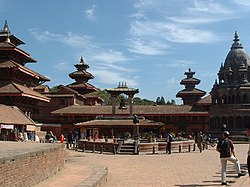[edit] History of Nepal
Before Nepal's emergence as a nation in the latter half of the 18th century, the designation 'Nepal' was largely applied only to the Kathmandu Valley and its surroundings. Thus, up to the unification of the country, Nepal's recorded history is largely that of the Kathmandu Valley. References to Nepal in the Mahabharata epic, in Puranas and in Buddhist and Jaina scriptures establish the country's antiquity as an independent political and territorial entity. The oldest Vamshavali or chronicle, the Gopalarajavamsavali, was copied from older manuscripts during the late 14th century, is a fairly reliable basis for Nepal's ancient history. The Vamshavalis mention the rule of several dynasties the Gopalas, the Abhiras and the Kiratas—over a stretch of millennia. However, no historical evidence exists for the rule of these legendary dynasties. The documented history of Nepal begins with the Changu Narayan temple inscription of King Manadeva I (c. 464-505 AD) of the
Lichavi dynasty.
[edit] Thakuri Dynasty
RULE OF THAKURI KINGS
Thakuri Dynasty was a Rajput Dynasty
After Aramudi, who is mentioned in the Kashmirian chronicle, the Rajatarangini of Kalhana (1150 CE), many Thakuri kings ruled over the country up to the middle of the 12th century AD. Raghava Deva is said to have founded a ruling dynasty in 879 AD, when the Lichhavi rule came to an end. To commemorate this important event, Raghu Deva started the 'Nepal Era' which began on 20 October, 879 AD. After Amshuvarma, who ruled from 605 AD onward, the Thakuris had lost power and they could regain it only in 869 AD.
GUNAKAMA DEVA
After the death of King Raghava Dev, many Thakuri kings ruled over Nepal up to the middle of the 12th century AD. During that period, Gunakama Deva was one of the famous kings. He ruled form 949 to 994 AD. During his rule, a big wooden house was built out of one single tree which was called 'Kasthamandapa', from which the name of the capital, 'Kathmandu', is derived. Gunakama Deva founded a town called Kantipur, the modern Kathmandu. According to the Vamsavali, this cost him a hundred thousand rupees a day. He built more than eighteen thousand houses there. It was also Gunakama Deva who started the 'Indra Jatra' festival. He repaired the temple that lies to the northern part of the temple of Pashupatinath. He also initiated the practice of worshipping Lumadi, Raktakali, Kankeshwari, Panchalinga, Bhairab and Manamaiju. He introduced Krishna Jatra and Lakhe Jatra as well. He also performed Kotihoma.
SUCCESSORS OF GUNAKAMA DEV
Bhola Deva succeeded Gunakama Deva. The next ruler was Laksmikama Deva who ruled from 1024 to 1040 AD. He built Laksmi Vihara and introduced the custom of worshipping a virgin girl as 'Kumari'. Then, Vijayakama Deva, the son of Laksmikama, became the king of Nepal. Vijaykama Deva was the last ruler of this dynasty. He introduced the worship of the "Naga" and "Vasuki". After his death, the Thakuri clan of Nuwakot occupied the throne of Nepal.
NUWAKOT THAKURI KINGS
Bhaskara Deva,a Thakuri form Nuwakot, succeeded Vijayakama Deva and established Nuwakot-Thakuri rule. He is said to have built Navabahal and Hemavarna Vihara. After Bhaskara Deva, four kings of this line ruled over the country. They were Bala Deva, Padma Deva, Nagarjuna Deva and Shankara Deva.
Shankara Deva (1067-1080 AD) was the most illustrious ruler of this dynasty. He established the image of 'Shantesvara Mahadeva' and 'Manohara Bhagavati'. The custom of pasting the pictures of Nagas and Vasuki on the doors of houses on the day of Nagapanchami was introduced by him. During his time, the Buddhists wreaked vengeance on the Hindu Brahmins (especially the followers of Shaivism) for the harm they had received earlier from Shankaracharya. Shankara Deva tried to pacify the Brahmins harassed by the Buddhists.
SURYAVANSI (SOLAR DYNASTY) RAJPUT KINGS
Bama Deva, a descendant of Amshuvarma, defeated Shankar Deva in 1080 AD. He suppressed the Nuwakot-Thankuris with the help of nobles and restored the old Solar Dynasty rule in Nepal for the second time. Harsha Deva, the successor of Bama Deva was a weak ruler. There was no unity among the nobles and they asserted themselves in their respective spheres of influence. Taking that opportunity, Nanya Deva, a Karnataka king invaded Nepal from Simraungarh. According to the chronicles, he made his residence at Bhadgaon. Mukunda Sena, the king of Palpa, too, the Nepal valley. It is said that after the invasion of Mukunda Sena, the tradition of making Hakuwa rice, Gundruk and Sinki began.
Shivadeva III
After Harsha Deva, Shivadeva, the third, ruled from 1099 to 1126 A.D. He was a brave and powerful king. He founded the town of Kirtipur and roofed the temple of Pashupatinath with gold. He introduced twenty-five paisa coins. He also constructed wells, canals and tanks at different places.
After Sivadeva III, Mahendra Deva, Mana Deva, Narendra Deva II, Ananda Deva, Rudra Deva, Amrita Deva, Ratna Deva II, Somesvara Deva, Gunakama Deva II, Lakmikama Deva III and Vijayakama Deva II ruled Nepal in quick succession. Historians differ about the rule of several kings and their respective times. After the fall of the Thakuri dynasty, a new dynasty was founded by Arideva or Ari Malla, popularly known as the 'Malla Dynasty'.
